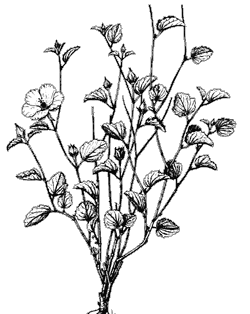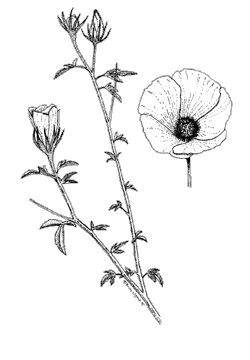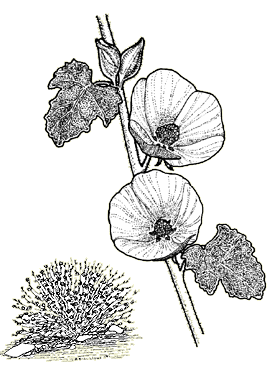Malvaceae (mallow family)
The mallows number about 1500 species worldwide; most are characterized by alternate, simple, palmate leaves with stellate (branched, star-shaped) hairs. Mallow flowers are easily recognized by the filaments, which are united into a tube surrounding the style. Familiar examples include hibiscus, cotton, okra, and hollyhock.
Hibiscus denudatus
English names: rock hibiscus,
rock rose mallow
Spanish name: none known
 |
Description
Rock hibiscus is a subshrub to a foot (30 cm) tall. The thin stems bear sparse foliage of triangular, gray leaves. One-inch (2.5 cm) flowers resemble those of the familiar tropical hibiscus; color ranges from white in the western part of its geographic range to deep purple-pink in the eastern end. Plants flower in response to rain during the warm season. Flowers can be found in almost any month below 1000 feet (300 m) elevation, but only in summer at 4000 feet (1200 m).
Notes
It grows throughout the Sonoran Desert to western Texas and central Mexico.
Hibiscus coulteri
English names: desert hibiscus,
desert rose mallow
Spanish names: tulipán (tulip), hibisco
 |
Description
Desert hibiscus is a weak-stemmed, sparsely-branched shrub to 3 feet (1 m) tall. The upper leaves are 3-lobed. Showy flowers almost 2 inches (5 cm) wide are light yellow with a purple spot on each of the 5 petals. They bloom nearly year round in response to rain. Plants are difficult to find when not in flower because they nearly always grow among other shrubs for support.
Range
It occurs from near Tucson to western Texas and northern Mexico.
Sphaeralcea ambigua
English names: desert globemallow, sore-eye poppy
Spanish names: mal de ojo
(sore eye), malvia, plantas muy malas (very bad plants)
Description
Desert globemallow is a short-lived subshrub; many stems with slightly woody bases arise from near ground level grow up to 3 feet (1 m) long. The stems grow in all directions from erect to horizontal forming a hemispherical mound when growing in the open. The triangular leaves are gray-hairy. Goblet-shaped flowers are about ¾ of an inch (20 mm) across. Throughout most of its range the flowers are apricot-colored to bright orange. Scattered populations with pink, lavender, red, or white flowers comprise the variety rosacea (Parish mallow). Plants flower profusely in spring and sparsely at other times following rains.
 |
Range
Desert globemallow is common in the deserts of California and Arizona and from Utah into Mexico.
Notes
There are several species of Sphaeralcea in the Sonoran Desert, and only experts on the genus can distinguish them with confidence. Sphaeralcea laxa, “caliche globemallow,” is most often confused with S. ambigua. These 2 perennial species can be distinguished only by microscopic examination of the seeds. Sphaeralcea emoryi and coulteri are winter annuals that are usually shorter and less branched than are the 2 perennial species.
Like the Spanish name, the O’odham name also means “sore eyes”; the name should be taken seriously. The very wet winter of 1998 produced huge fields of globemallows 5 feet (1.5 m) tall in many desert areas. On a Desert Museum expedition to Baja California we drove through a patch on a warm day with the windows down. The road was so narrow that the side mirrors slapped the mallows on both sides of the vehicle. Our resultant misery reminded us that stellate hairs probably evolved to discourage herbivores.










